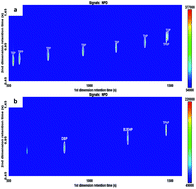当前位置:
X-MOL 学术
›
Anal. Methods
›
论文详情
Our official English website, www.x-mol.net, welcomes your feedback! (Note: you will need to create a separate account there.)
The analysis of alkyl phosphates in nitrogen-rich crude oils using GC × GC-NPD with a polar/apolar column configuration
Analytical Methods ( IF 3.1 ) Pub Date : 2017-08-22 00:00:00 , DOI: 10.1039/c7ay01519d Keisean A. J. M. Stevenson 1, 2, 3, 4 , James J. Harynuk 1, 2, 3, 4
Analytical Methods ( IF 3.1 ) Pub Date : 2017-08-22 00:00:00 , DOI: 10.1039/c7ay01519d Keisean A. J. M. Stevenson 1, 2, 3, 4 , James J. Harynuk 1, 2, 3, 4
Affiliation

|
Alkyl phosphates in crude oils originate from their use as gellants used in some hydraulic fracturing processes or as additives used to improve physical properties of the oil for transportation. Alkyl phosphates are a potential issue for used oil re-refining and recycling operations because of their use as flame-retardants in, for example, aviation hydraulic fluids. The primary concern with alkyl phosphates in the refinery is their association with refinery fouling, including deposit formation and catalyst deactivation. A comprehensive two-dimensional gas chromatography method, with nitrogen phosphorus detection (GC × GC-NPD) and post-column Deans switching, was previously developed by our group for quantitative analysis of alkyl phosphates in petroleum samples. The original method employed an apolar/polar GC × GC column configuration and was shown to provide trace speciation of alkyl phosphates in distillate samples and some crude oils. However, when petroleum samples having a high concentration of heavy nitrogen-containing species were encountered, coelutions with alkyl phosphates ensued. Even in a phosphorus-optimized NPD configuration, the background signal from nitrogen-containing species masked the signals of some alkyl phosphates. Thus, a new column configuration using a polar/apolar GC × GC column set was developed. The results of this study are presented, showing the applicability of this method to the analysis of alkyl phosphates in petroleum samples with a high concentration of nitrogen-containing species. This method effectively separates the alkyl phosphates from nitrogen containing species with which they previously co-eluted. Additionally, it allows for trace speciation and quantification of alkyl phosphates in crude-oil with detection limits ranging from 0.001 to 0.02 μg phosphorus per mL.
中文翻译:

使用具有极性/非极性色谱柱配置的GC×GC-NPD分析富氮原油中的烷基磷酸酯
原油中的磷酸烷基酯源自其在某些水力压裂工艺中用作胶凝剂或用于改善运输油的物理性能的添加剂。磷酸烷基酯由于其在例如航空液压油中用作阻燃剂,因此对于废油的精炼和再循环操作而言是一个潜在的问题。炼油厂中烷基磷酸酯的主要问题是它们与炼油厂结垢的关系,包括沉积物的形成和催化剂的失活。我们小组先前开发了一种具有氮磷检测(GC×GC-NPD)和柱后Deans转换功能的全面二维气相色谱方法,用于定量分析石油样品中的烷基磷酸盐。原始方法采用了非极性/极性GC×GC色谱柱配置,并被证明可在馏出物样品和某些原油中提供痕量烷基磷酸酯的形态。然而,当遇到具有高浓度的重含氮物质的石油样品时,随之而来的是烷基磷酸酯的共洗脱。即使在磷优化的NPD配置中,来自含氮物质的背景信号也掩盖了某些烷基磷酸酯的信号。因此,开发了使用极性/非极性GC×GC色谱柱组的新色谱柱配置。介绍了这项研究的结果,表明该方法适用于分析高浓度含氮物质的石油样品中的烷基磷酸酯。该方法有效地将烷基磷酸酯与它们先前共同洗脱的含氮物质分离。此外,它允许对原油中的磷酸烷基酯进行痕量形态分析和定量分析,检测限范围为每毫升0.001至0.02μg磷。
更新日期:2017-09-21
中文翻译:

使用具有极性/非极性色谱柱配置的GC×GC-NPD分析富氮原油中的烷基磷酸酯
原油中的磷酸烷基酯源自其在某些水力压裂工艺中用作胶凝剂或用于改善运输油的物理性能的添加剂。磷酸烷基酯由于其在例如航空液压油中用作阻燃剂,因此对于废油的精炼和再循环操作而言是一个潜在的问题。炼油厂中烷基磷酸酯的主要问题是它们与炼油厂结垢的关系,包括沉积物的形成和催化剂的失活。我们小组先前开发了一种具有氮磷检测(GC×GC-NPD)和柱后Deans转换功能的全面二维气相色谱方法,用于定量分析石油样品中的烷基磷酸盐。原始方法采用了非极性/极性GC×GC色谱柱配置,并被证明可在馏出物样品和某些原油中提供痕量烷基磷酸酯的形态。然而,当遇到具有高浓度的重含氮物质的石油样品时,随之而来的是烷基磷酸酯的共洗脱。即使在磷优化的NPD配置中,来自含氮物质的背景信号也掩盖了某些烷基磷酸酯的信号。因此,开发了使用极性/非极性GC×GC色谱柱组的新色谱柱配置。介绍了这项研究的结果,表明该方法适用于分析高浓度含氮物质的石油样品中的烷基磷酸酯。该方法有效地将烷基磷酸酯与它们先前共同洗脱的含氮物质分离。此外,它允许对原油中的磷酸烷基酯进行痕量形态分析和定量分析,检测限范围为每毫升0.001至0.02μg磷。



























 京公网安备 11010802027423号
京公网安备 11010802027423号